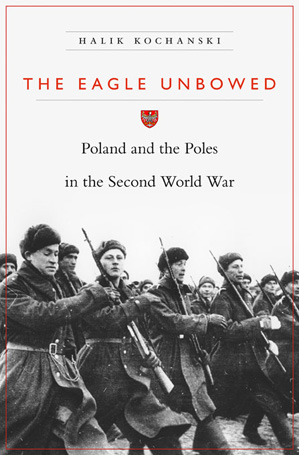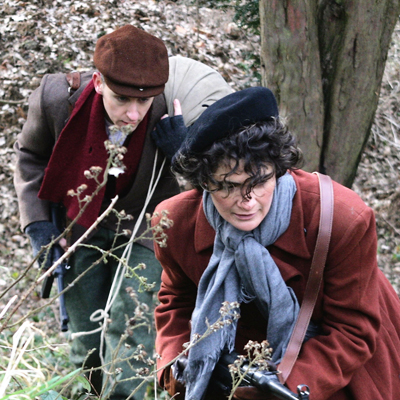 The Eagle Unbowed: Poland and the Poles in the Second World War
The Eagle Unbowed: Poland and the Poles in the Second World War
Halik Kochanski
London: Allen Lane, 2012; 734 pages
In early 1946, the British government sent invitations to the Victory Parade in London. With the exception of a handful of pilots who had fought in the Battle of Britain, members and commanders of the Polish Armed Forces in the West found themselves excluded from the defilade. The decision of the Labor government prompted ten British MPs to send a letter of protest to the Daily Telegraph newspaper. “Ethiopians will be there, Mexicans will be there, the Fiji Medical Corps, the Labuan Police and the Seychelles Pioneer Corps will there – and rightly so,” read the letter. “But the Poles will not be there. Have we lost not only our sense of perspective but our sense of gratitude as well?” On June 8, 1946, the parade took place without the participation of any Polish representatives. Poland, the first country to be invaded by the Nazis during World War II, the state over which Britain and France went to war against Germany, not only lost the war but also its sovereignty for four long decades.
In her comprehensive survey of wartime Poland, Halik Kochanski unveils to a broad audience one of the most neglected and misrepresented chapters of World War II. While The Eagle Unbound is not the first English-language study to focus on the Polish war effort and contributions to the Allied victory, the Nazi and Soviet crimes, and the communist takeover, it is perhaps the first book, which aims to tie together military and diplomatic history, the fate of civilians at home and abroad, and the multifaceted world of Polish and global politics. The British-born daughter of Polish wartime refugees, Kochanski promises to deliver “not a nationalistic study,” but the impartial, “most complete picture of the Poles and Poland in the Second World War.” And she largely does it.
A renowned military historian, Kochanski does an outstanding job referring to Poland’s contributions to the war against the Nazis including the September 1939 campaign, the war, which could not be won due to Germany’s sheer manpower and technical superiority, the Allies’ lack of willingness to engage the Wehrmacht, and the ineptitude shown by the Polish high command. She then details the participation of Polish military units on the Western, African and Eastern fronts from 1940 to 1945, including the battles of Britain and Monte Cassino.
Yet it is quite chilling to learn about the unjust scapegoating of the Polish Parachute Brigade and its commander, General Stanisław Sosabowski, by inept British commanders after the failure of Operation Market Garden in Holland in 1944. Despite their collapsing morale in the final months of the war, Polish soldiers fought on. Kochanski finishes her chapter 15 by quoting a letter from a Polish pilot from February 1945, after the Yalta agreements had been made clear: “The sorties have been ordered, so we’re going to fly – it’s the proper thing to do – although anger and despair are in our hearts. It’s a funny feeling, but sometimes I wonder if all this has any sense. If the Germans get me now, I won’t even know what I’m dying for. For Poland, for Britain, or for Russia?”
Kochanski’s coverage of the armed forces commanded by the Soviets is particularly valid considering how little attention Western historians has paid to these units. She also highlights such exploits of the Polish military intelligence and underground movement as breaking the codes of the German Enigma cipher machine by Polish cryptographers and providing crucial evidence on the V1 and V2 flying bombs and rockets. The story of the Home Army also brings an unpleasant truth about how little support Polish resisters received from the Allies. Notwithstanding the technical difficulties of supplying missions, this lack of help was, above all, the result of the pressure by the Soviets on Britain and the U.S. not to aid political and military forces in occupied Poland which they deemed hostile and, rightly so, opposed to subduing of the country by Moscow.
Stalin’s determination to keep the territories conquered in 1939 and to dominate Poland comes as no surprise. Yet the book’s chapters that chronicle the evolving treatment of the Polish Government-in-Exile by London and Washington from the position of a junior coalition partner to that of “an inconvenient ally” after the Nazi invasion of the Soviet Union in 1941 are particularly chilling. The portrayals of Churchill and FDR in this book are unflattering. We can see the British leader zigzagging between displaying admiration for Poles and bullying them into accommodating to the Soviet Union in accordance to the spirit of realpolitik. At times we can also witness the cold attitude of a warlord. Consider Churchill’s telegraph to foreign minister Eden upon receiving reports on the growing numbers of Polish civilians evacuated from the Soviet Union into Iran in 1942: “Are we going to get nothing but women and children? We must have the men.”
Churchill’s position was the result of Britain’s weakness and marginalization in the Allied war effort. Roosevelt’s attitude toward the Polish allies, however, reflects the ever-present priority of domestic politics and American interests. Hoping to obtain the Polish American electoral vote and the Soviet assistance in the defeat of Japan, he misled Polish Prime Minister Stanisław Mikołajczyk into believing in the US unwavering support for Polish territorial integrity a long time after he had agreed to Stalin’s territorial demands at the expense of Poland. Worse, he showed no sensitivity to the discovery of the Katyń massacre of Polish officers by the Soviets snapping at the Polish ambassador that “the Poles had been foolish about the ‘graves question.’” While the Red Army’s drive into Eastern Europe in 1944-45 sealed the allocation of this part of Europe into the Soviet sphere of influence, Western leaders did very little to alleviate this threat.
Kochanski scores the most interesting points while covering the plight of Poles, both military personnel and civilians, outside of Poland. In fact, her chapters 5, 6 and 8 on the Poles in the Soviet Union and in exile are probably the strongest sections of the book. She extensively uses interviews with survivors and memoirs to detail the harrowing experience of Polish deportees and refugees. Consider the story of Stanisław Kochański, the author’s father. Evacuated from the Soviet Union to Iran and accepted for training as a bombing pilot, he spent several months in transit, first seeing his ship torpedoed by U-boats, then being interned by Vichy Frenchmen in Morocco, and finally sailing to Britain after the Allied invasion of North Africa. One of the most fascinating segments of this book deals with the fate of Polish refugees in Hungary. A Nazi ally, the Hungarian government tolerated and supported the networks of Polish educating, cultural and social institutions, allowed the passage of Polish patriots to the West, and even accommodated the creation of resistance structures until the German occupation of the country in 1944.
That being said, Kochanski’s book does have flaws. One of the most problematic statements comes in the section on definitions of Poland and the Poles. After detailing the ethnic split of the overall population of the Second Polish Republic, the author states: “These were all Polish citizens and will be considered as such throughout this book. At times, it will be necessary to point out the ethnicity of certain Poles.” The question I would like to pose here is whether some Ukrainians, Germans, and Belorussians had ever considered themselves Poles. The issue of identity matters in the country, which, very much like the rest of prewar Europe, failed to resolve the problem of minorities. The fact is that the Polish governments that ruled the country in the 1920s and ‘30s treated this multiethnic conglomerate as the nation state of ethnic Poles. Hence terms ‘Poles’ and ‘Polish citizens’ may not necessarily be one and the same in the prewar period.
And if we want to take seriously the author’s original plea to respect the multiethnic character of the Polish nation, let us have a look at appendix 2 “principal Polish personalities.” The gallery of military and political leaders includes all but two (Jakub Berman and Oskar Lange) ethnic Poles, with no references given to such characters as Szmul Zygielbojm, a Jewish socialist Bund leader and a member of the Polish National Council in London, who committed suicide as a protest against the Allies’ inaction with respect to the Holocaust. Consider another unmentioned figure, Bishop Andrey Sheptytsky, the leader of the Uniate Church before and during WWII, who chose to be Ukrainian (his own brother was a prominent Polish general), supported Ukrainian independence and nationalism, but also opposed the Holocaust.
The chapters on prewar Poland are the weakest parts of the book. They contain mistakes and potentially misleading statements. For example, it was not the National Democrats who participated in the Sanacja’s Camp of United Poland, but their fascist, breakaway offspring from the National Radical Movement. Far worse is the treatment of prewar Polish anti-Semitism described by Kochanski as economically driven due to the struggle between the Polish aspiring middle class and Jews and the Great Depression. She ignores the racist component of Roman Dmowski’s National Democratic movement. The Jewish university students subjected to the “bench ghettos” in the 1930s were not upstarts from shtetls but Jewish Poles who considered themselves assimilated and detached from the Yiddish-speaking Orthodox Jews. The Polish nationalists focused their assault on assimilated Jews; they viewed these people, including converts to Catholicism, as parasitic and unfit for assimilation.
Regarding the Holocaust and anti-Jewish violence, Kochanski’s account has aptly been described as ‘fair-minded,’ yet it is not free from problematic statements. Having researched nationalists’ attitude toward the Final Solution, I doubt that we can fully second the author’s remarks on the overall indignation shown by the Polish Resistance and society toward the murder of the Jews. As Kochanski points out, numerous Poles benefited from the takeover of Jewish property. Some blackmailed and denounced Jews. It is also true that the Home Army condemned anti-Semitism, yet some of its local units went beyond liquidating “Jewish bandits.” The 1941 massacre of Jews by Poles in Jedwabne cannot be simply attributed to the Nazis’ pressure and revenge for the Jewish involvement in the Soviet occupation. Explaining postwar pogroms by the resentment towards Jewish communists or fear of losing former Jewish property to its original owners is not enough. We have to take into consideration the prevalent myth of Jewish ritual murder, revived in postwar months and present in such locations as Kielce in 1946, and overall desensitization with violence.
These omissions may stem from the fact that Kochanski is reluctant to quote non-English sources. The scarcity of references to Polish, German, Russian or Ukrainian literature makes this book less up-to-date with the state of current historical research, especially in Poland. I would also encourage the author and editors to fix factual mistakes and typographical errors in Polish and non-English names.
These shortcomings do not change the fact that The Eagle Unbowed is a very competent, engaging, well-balanced and well-written survey of Poland and the Poles in World War II. I would highly recommend this work to anyone interested in Polish and wartime history.
CR




Pingback: “Heroes of War”